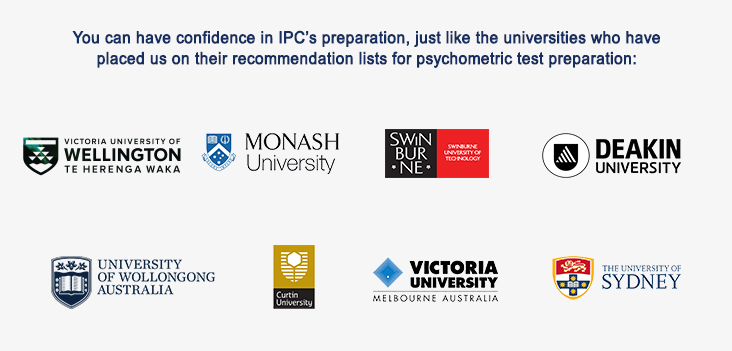Preparing for the Department of Fire and Emergency Services WA (DFES) Cognitive and Personality Assessments 2024
If you are applying to join Department of Fire and Emergency Services (DFES) , you will be asked to complete a variety of cognitive and personality tests as part of your entrance exam.
In the screening phase, you will be asked to complete a set of Cognitive and Personality tests focusing on: :
- Numerical reasoning
- Verbal reasoning
- Diagrammatic reasoning
- Mechanical reasoning
- Error checking
- Spatial reasoning
- Personality profiling
Department of Fire and Emergency Services (DFES) - verbal reasoning test questions
Department of Fire and Emergency Services (DFES) verbal reasoning test questions are designed to measure your verbal reasoning ability. The set of test questions include several verbal test question types: deductive reasoning, word associations, odd one out and logical thinking.
Let's check the following DFES verbal test question examples:
DFES verbal test question example 1:
Which two statements together prove that Tim has a red car?
A. Gil likes Tim's car colour
B. Tim likes fast cars
C. Gil has a fast car
D. Gil likes only red cars
E. Tim's car is not silver
DFES verbal test question example 2:
Which are the two odd-ones out?
A. Borrow
B. Trade
C. Sell
D. Rent
E. Loan
F. Lease
Department of Fire and Emergency Services (DFES) - numerical reasoning test questions
The numerical section of DFES' test includes several numerical question types: traditional number series, graphs and tables, basic arithmetic, formula based numerical questions and basic quantitative questions.
Let's check the following DFES numerical test questions examples:
DFES numerical test question example 1:
Tom has been flying his small jet for 30 minutes and has travelled 200 Kilometres. What has been his average speed in Kilometres per hour?
To answer this question, we need to first change the time Tom has been flying from minutes to hours. As there are 60 minutes in an hour, 30 minutes equals 0.5 hours. Then, we need to divide the distance by time to find the speed in which Tom was flying. 200km/0.5 hours = 400 km per hour.
DFES numerical test question example 2:
Each dough machine at Paula’s Bakehouse can make 2 large dough batches in an hour. She has 3 of these machines. How many batches of dough can Paula make in 6 hours?
To solve this question, we need to calculate how much can each machine make in one hour and multiply this by 3 machines and by 6 hours. If one machine can make 2 batches in one hour then, 3 machines can make 3 x 2 batches = 6 batches per hour. Then, in 6 hours the 3 machines can make 6 x 6 batches per hour = 36 batches in 6 hours.
DFES numerical test question example 3:
44 out of 400 is what percent?
To solve this question, we need to understand percentage. A percentage means how many times can a section fit into a whole. If the whole is 400 and the section is 44 then, (44/400) x 100 will be 44 out of 400 in percentage.
DFES numerical test question example 4:
Wat is the smallest value out of the following numbers?
0.0012
0.0015
0.0101
0.0122
To answer this question, we need to evaluate all the numbers. The first rule is that if the number has a decimal point then as the number has more zeros on the right side of the decimal point the value of this number is smaller. Therefore, we can see that 0.0012 and 0.0015 are smaller than 0.0101 and 0.0122 simply due to the number of zeros to the right of the decimal point. Then, as 12 is smaller than 15, 0.0012 is smaller than 0.0015.
DFES numerical test question example 5:
What is the next number is this series: 1, 4, 9, 16, 25, ?
To answer this question, we need to find a pattern that fits the sequence of numbers. In this case the pattern is +3, +5, +7, +9,,,. Therefore, the next number will be 25 + 11 = 36.
Department of Fire and Emergency Services (DFES) - abstract reasoning test questions
This set of test questions are designed to measure your abstract reasoning ability. In this type of test questions you are presented with a group of shapes or items. You will need to quickly identify the pattern or patterns across all shapes in order to answer the question. This section includes several test question types: find the next shape, find the missing shape, find the association, find the odd one out.
Let's review the following example, here we can see a group of shapes. Your task is to find wWhich of the shapes doesn’t belong with the others.

To answer this question we need to find the patterns or logical rules that make up this list of shapes going from left to right. When reviewing the three shapes we can identify the following patterns:
1. Each shape has a half white and half black inner shapes.
2. The black and white inner shapes are mirror image..
3. There is a stick or pole coming out from the centre or point of connection between the black and white inner shapes.
As the odd-one-out is a shape that does not incorporate all three patterns, the first shape is the odd-one-out.
Department of Fire and Emergency Services (DFES) - error checking test questions
This set of test questions is designed to measure your ability to pay attention to details. Each of DFES' error checking test question will introduce 2 similar lists of information. The two lists of written items will be similar but not identical. They will have small differences in letters or signs. You will be asked to identify how many items on both lists are identical.
Let's review the following test question example:
How many items on both lists are identical?
McDowell Corp. McDowel Corp.
Finickers Fish ‘n’ Chips Finichers Fish ‘n’ Chips
Eastern Star Co-Op Eastern Star Co-Op
Carthagie Cricket Team Carthagie Cricket Team
Minnie’s Ice Creamry Minnies Ice Creamery
To answer this question, you need to compare the details f the two lists. The first pair of items has a mistake. There are two l’s in the first ‘McDowell’ and only one in the second. The second pair has ‘Finickers’ in the first column with a ‘ck’ and in the second with a ‘ch’. The third and fourth entries are identical but the last entry has ‘Creamry’ vs ‘Creamery’, there’s an ‘e’ missing. The correct answer is 2.
Department of Fire and Emergency Services (DFES) - diagramatic reasoning test questions
DFES' diagramatic reasoning test is designed to measure your problem-solving skills, your ability to make decisions with partial information and your strategic thinking. DFES' diagrammatic test typically includes a series of test questions that you need to complete under time constraints. This style of test questions was designed to measure you ability to understand logical processes. Each question has a set of input and output figures and a number of operators/effects. The operations/effects' function is described in text and in illustrations. In each question there is one element missing - either the input figures or output figures or the operations.
DFES' diagrammatic test is broken down into several groups of 4 questions and has 2 mins to answer each group of 4.
Let's review the following DFES diagrammatic test question example:

The question is:

To solve this diagrammatic test question you need to identify the correct sequence of ‘input’ shapes based on the provided sequence of ‘output’ shapes. For this style of question, you are not provided the input sequence, rather, only the output sequence and an “Effect Operator”. These operators modify the input shapes in different ways to transform them into the output result. To solve this task, you must work backwards starting with the output sequence with reference to the operator and applying the effect in reverse to identify the correct input sequence.
In this question there is only one operator or effect. Based on the illustrated instruction panel, effect * changes the shapes and sizes of all white figures (from squares to circles or from circles to squares and from big to small or small to big). To reverse this effect, we need to change back all the white figures’ shapes and sizes. This means changing the first small, white square into a big, white circle and changing the second figure, which is a big, white circle into a small, white square. The sequence of figures after reversing this effect is: a big, white circle, followed by a small, white square and a small, black circle.
Department of Fire and Emergency Services (DFES) - emotional intelligence test questions
The emotional intelligence test was developed as a reasoning measurement of people’s emotional intelligence using 3 distinctive aspects of your emotional intelligence.
- Ability to identify emotions in facial expressions.
- Ability to identify people's emotions based on their behaviour.
- Ability to manage emotions.
DFES' emotional intelligence test includes 3 parts:
Part 1 measures your ability to identify emotions in facial expressions. This section is timed. You have 3 seconds to identify an emotion on someone's face.
Part 2 measures your ability to identify people's emotions based on a scenario or situation. This section is timed. You have 1 minute for each test screen.
Part 3 measures your ability to manage emotions. This section is not timed. You will need to select a corse of action to emotionally based scenarios.
The challenge with DFES' emotional intelligence test:
Contrary to most Emotional Intelligence tests used in the market, DFES' test is a reasoning rather than a personality based test. This means that the DFES' emotional intelligence test regards EI as a cognitive ability and therefore uses a timer as part of the test.
What is a DFES Emotional Intelligence test question?
The DFES test has two types of test questions:
The first type or test question style includes a short scenario that describes a situation about one or two people. Then you are asked to decide what is each person in the scenario likely to feel. Your answer will not only include the emotion but also the facial expression that conveys the correct emotion.
The second type or test question style includes a screenshot of a face and you are asked to decide whether this facial expression conveys a specific emotion. Your answer can only be yes or no.
Let's review the following example test question for the DFES emotional intelligence test:

Is this Surprise?
Here you need to analyse the facial expression to identify the correct emotion.
Criteria has designed several Personality Tests which are used by employers to assess job candidates’ behavioural style. The most popular tests are:
Department of Fire and Emergency Services (DFES) - Personality and Behavioural Assessment
DFES uses several personality tests to measure your personality profile. Some are clinical personality assessments and some are work-related personality tests.
All DFES' personality and behavioural assessments are untimed.
Let's check the following DFES' personality assessment question example:
I prefer playing tennis than basketball?
A. Strongly disagree
B. Disagree
C. Neutral
D. Agree
H. Strongly agree
This personality assessment question measures in a covert manner your social skills and your ability to work well in a team.
In your DFES practice personality test you will receive detailed answer explanations to allow you to understand what each question measures and how to answer so you can emphasize your strengths.
How IPC helps you to prepare for the Department of Fire and Emergency Services (DFES) cognitive and personality assessments
The Institute of Psychometric Coaching (IPC) has developed a variety of tailored preparations to ensure you are ready for your cognitive test. Our professionals have analysed strategies and techniques and developed a full range of countermeasures. Our preparations include:
1. Online specific DFES cognitive and personality practice assessments
- A large pool of online practice cognitive tests – tailor for DFES' cognitive assessments.
- A large pool of clinical and work-related personality assessments tailored to DFES
- Step by step solutions at the end of each assessment
- Test scores in comparison to others
- Feedback on how to improve
Benefits include:
- Based on real DFES cognitive and personality assessment questions
- Timer mimics the pressure of taking the real test
- Immediate access
2. Face-to-face tutoring for DFES' cognitive and personality assessments as well as for the interview.
Experience gold standard service with IPC’s personal tutoring.
Our personalised service includes:
- One-on-one personal tutoring delivered by experienced Psychometricians.
- Face to face sessions (in our Melbourne and Sydney offices) or via Skype live
- In depth analysis of your cognitive weaknesses to focus the session and maximise your scores
- Working together to ensure you reach maximum potential and capabilities in your DFES' Cognitive and Personality assessments







